BREAKING NEWS! Today (one hundred years ago), Babe Ruth was sold by the Red Sox to the Yankees. That may be the biggest “hot stove” news in baseball history.
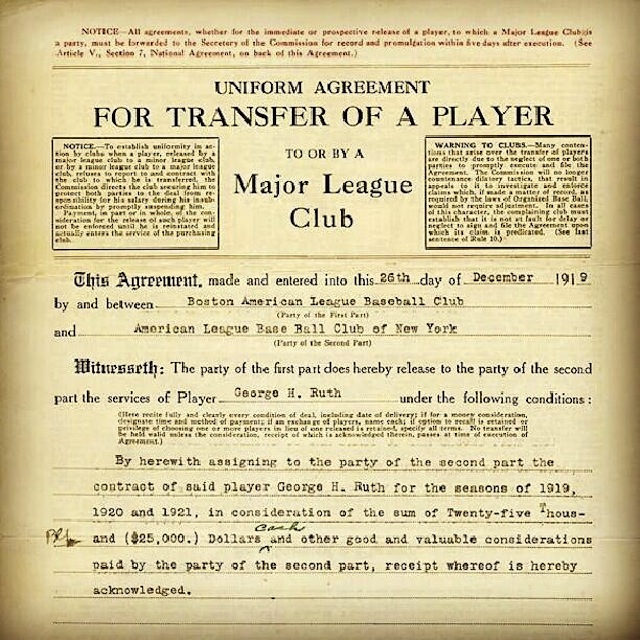
As many of you know, I borrowed the title of my newsletter from the “Hot Stove League,” a term used to identify the baseball offseason – running from the end of the World Series to the opening of spring training. The primary activity for fans of the Hot Stove League is talking about the next season, originally envisioned as a conversation while huddled around a hot stove. We still talk about baseball in the offseason, but the hot stove has been superseded by the furnace, emails, the internet and ESPN. And Babe Ruth news has been replaced by nine-figure free agent contracts. Let’s take a look at that transition.
Hot Stove League – Then: The nostalgia of the baseball offseason is nicely captured in this 1956 Norman Rockwell painting titled Hot Stove League:
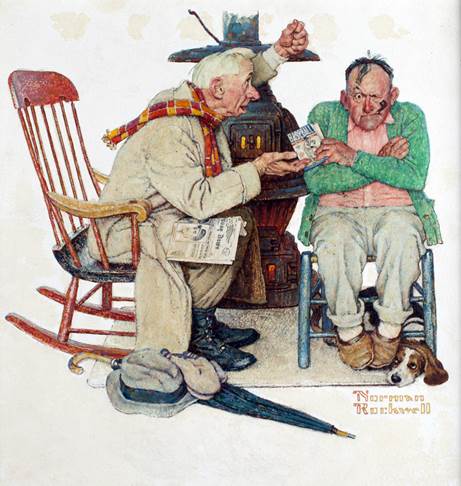
Rockwell’s painting was created for the winter page of a Brown & Bigelow four-season calendar. It shows two men bickering about baseball while seated by a potbelly-style hot stove. The pipe smoker is holding a baseball magazine. The other gentleman has a copy of The Sporting News, the so-called “Bible of Baseball,” which was founded in St. Louis in 1886 by Alfred H. Spink.
The original Rockwell painting was purchased by the Spink family and later donated by them to the St. Louis Art Museum.
Hot Stove League – Now: The hot stove of Norman Rockwell is now an anachronism. As for The Sporting News, it was sold by the Spink family in 1977 and became a digital-only publication in 2011.
For baseball news and discussion these days, we still banter with our friends, but there is also a gigantic supply of news, stats and stories via the internet, podcasts and social media. There is so much available that a form of triage is necessary to keep your inbox from filling up. Below are the primary sources I use. I also follow some sportswriters on Twitter to get real time comments and links to their articles as they come out. If you do not use Twitter, just use Google to find them on the web.
Kansas City Star: I take the digital version of the paper and follow the tweets of Vahe Gregorian, Sam Mellinger, Pete Grathoff, Lynn Worthy (Royals beat writer) and Lee Judge (still occasionally posting as a contributor). A benefit of the digital paper is that an extra 20 to 30 pages of sports is online – such things as box scores, stats and national stories.
For those who do not take the KC Star, you can sign up for “Sports Pass” to get their full sports coverage online. $30/year.

Royals Review: This website (click here) is the home of several part-time contributors, plus it links to many other sources (see especially the “Royals Rumblings” posts). Tons of Royals news.
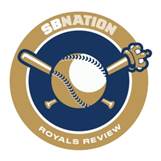
The Athletic: This is a subscriber site that costs about $5/month. Worth every penny. Several well-known national writers (e.g., Joe Posnanski, Ken Rosenthal, Molly Knight and Peter Gammons). Two refugees from the Star: Rustin Dodd and Andy McCullough. Royals beat: Alec Lewis. It covers many sports and teams, and you can sign up for a daily newsletter with targeted info (like Chiefs and Royals). There is also an app for your phone.

Last week, Joe Posnanski started an essay series in The Athletic that will run daily as he counts down the greatest 100 baseball players of all time – the series will be completed on Opening Day
Baseball Reference and Wikipedia: If you want info on any player or team, just Google the name, and the first two results will almost always be these two excellent sites.
Other Twitter Sources: Jeffrey Flanagan – Former Star sportswriter now with MLB.com. Jeff Passan – Another former Star sportswriter, now with ESPN. Rany Jazayerli – Former Royals blogger who is now a dermatologist in Chicago – but still writes about the Royals and Chiefs (very good Patrick Mahomes piece here). Jay Jaffee – Prolific writer on FanGraphs, best known for his Hall of Fame writing (his Cooperstown Casebook published in 2017 is the bible for evaluating Hall of Fame eligibility).
As free agents are being signed, the stat WAR is often in the news. The two sources of WAR numbers are Baseball Reference (bWAR) and FanGraphs (fWAR). The two are not interchangeable because they aggregate different skills and apply different weights, but they are generally in the same…ballpark. For the nerds who want to dig deeper, see an explanation of WAR in Hot Stove #5.
Another good way to engage with baseball during the winter is to go to two excellent museums in the area.
Negro Leagues Baseball Museum: I have written many times in Hot Stove about the Negro Leagues Baseball Museum. It is rightly called a gem of Kansas City.
This coming year will be special. February 13, 2020, is the 100th anniversary of the founding of the Negro National League, the first successful professional baseball league for African American and Hispanic players. The historic 1920 meeting of eight team owners was held in Kansas City at the Paseo YMCA, two blocks from the museum. The YMCA building still stands (below) and is slated to be the future home of the John “Buck” O’Neil Education and Research Center.
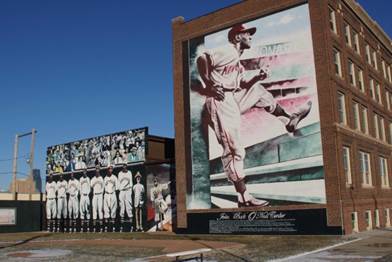
The museum is kicking off its centennial events on February 13 with the opening of an art exhibit of over 200 portraits depicting a visual history of the Negro Leagues. I’ll post updates in Hot Stove as the year of celebration unfolds.
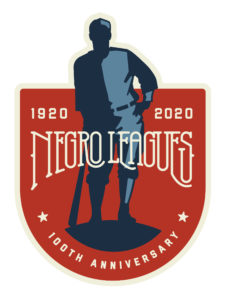
Chappell’s Restaurant and Sports Museum: Jim Chappell opened his restaurant in North Kansas City in 1986. But it became much more than just a good place to have lunch or dinner.
From boyhood, Jim kept scrapbooks about sports and began collecting memorabilia. He never stopped, and over the years, the collection grew and now covers every wall and ceiling space in the restaurant. I have seen it referred to as “Cooperstown West,” an apt description. Babe Ruth autographs. A World Series trophy. Scorecards, baseball cards, uniforms, etc. from the Blues, Monarchs, A’s and Royals. Home plate from Municipal Stadium signed by the 1955 A’s and several Monarchs. Items related to many Hall of Famers.
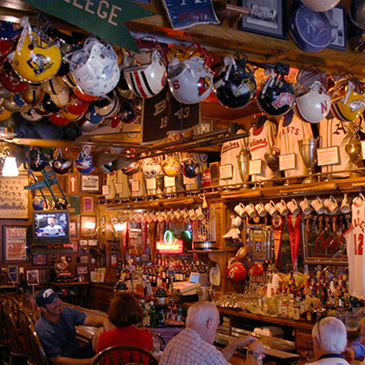
And that’s just the baseball. There is a large trove of memorabilia for the Chiefs, Kings, KU, MU and many other pro and college teams. Over a thousand football helmets hang from the ceiling – every big college and pro team plus any high school within a hundred miles of Kansas City. Michael Jordan’s autographed Olympics jersey. Sylvester Stallone’s boxing gloves from Rocky. I’m going to stop there – it would take a series of books to list the details. To get a flavor, click here for a brief Channel 9 interview (1:35) and here for the website.
If you have not been to Chappell’s, please treat yourself. If you have, it’s probably time to revisit and see some things you missed among the thousands of items.
Last year, Jim decided it was time to retire and sell his business. The restaurant and memorabilia collection are now owned by a group of investors led by real estate developer David Block. David’s team is running Chappell’s in the same tradition as Jim, and you can often find Jim there at lunch greeting old friends. If Jim is there when you arrive, ask him to point out the helmet of your high school or college – he will know where it is.
I recently joined Jim (left), David Block (red sweater) and David’s daughter Jamie at Chappell’s. A small part of the collection is behind us.
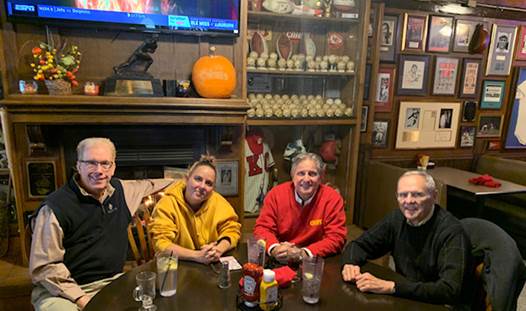
[Chappell Trivia: Rita and I are loyal viewers of CBS Sunday Morning, and so are familiar with Bill Geist, a regular correspondent on the show. Earlier this year, Geist promoted his new memoir, Lake of the Ozarks: My Surreal Summers in a Vanishing America, about the summers he worked at Arrowhead Lodge in the 1960s (fun clip here – 2:42). One of his fellow workers at Arrowhead was Jim Chappell who gets several mentions in the book. Jim met another college student while working there, his wife Gina (53 years and counting). The book is an entertaining read.]
Ken “Hawk” Harrelson, Dick Howser and Charlie Finley: Kansas City A’s fans from the 1960s will remember Ken Harrelson. He is in the news this month because he was just named the 2020 recipient of the Hall of Fame’s Ford C. Frick Award for excellence in broadcasting. The Royals Denny Matthews received the award in 2007. This is a very prestigious award that has gone to the likes of Mel Allen, Red Barber, Vin Scully and Bob Costas. Harrelson has been in the broadcast booth for over 40 years, 34 of them with the Chicago White Sox. That’s all very nice, but I’m going to skip the broadcasting part and go back to the Hawk’s playing days.
Ken Harrelson and I were born a month apart in August/September of 1941. In the spring of 1959, I was graduating from high school, listening to Chuck Berry and going to the drag strip. The 17-year-old Harrelson was signing a contract with the Kansas City A’s and heading to the Gulf Coast Instructional League in Florida. His teammates, just like his childhood friends had done, made fun of his beak-like nose (a result of being broken several times).
Teammate Dick Howser began calling him “Henrietta Hawk,” after a cartoon character. To make things worse, Harrelson started the season in a bad slump. He asked Howser to lay off, and Howser said he would whenever Ken started hitting. The next day, Harrelson hit two homers. So Howser dropped the Henrietta, but the Hawk stuck.
[Hawk Trivia: Although Harrelson thinks he was called Henrietta, the character Howser was referring to was likely Henery Hawk of Looney Tunes fame.]

[Howser Trivia: Dick Howser played three years for the Kansas City A’s in the early 60’s. While in KC, he met and married his first wife Michelle, a first cousin of David Block (as in Chappell’s above; small world). Howser returned to KC to manage the Royals from 1981 to 1986, leading them to a World Series win in 1985.]
Harrelson worked his way up through the minors and played partial seasons for the A’s in 1963 and 1964. In a night game against the Yankees on September 4, 1964, the Hawk was (maybe) the first to use a batting (golf) glove in an official game. Hitters had used gloves before, but usually for batting practice or preseason. It was not common for regular season games. But serendipity was in play that night.
Harrelson was being platooned and assumed he would not be playing because the Yankees were starting a right hander. He spent the day on the golf course – he was a superb golfer – and played 27 holes. That night, Yankee manager Yogi Berra made a late change and started lefty Whitey Ford. So Hawk started, but he had a problem. The long golf day left him with a blistered left hand. He still had his golf glove with him and found that it helped with the pain when he gripped the bat. The Yankee bench jockeys made fun of him for using the glove, but he hit two homers (one off of Whitey Ford).
The next day, the Yankees continued to mock the Hawk. Mickey Mantle had the Yankees clubhouse guy buy 20 golf gloves for team batting practice. They called the Hawk “sweetheart” and “Mrs. Harrelson.” They had their fun, but Harrelson had the last laugh. He started a trend and is given credit for popularizing the use of batting gloves. Almost all players use them today (often delaying games with OCD glove adjustment between every pitch, like our beloved Lorenzo Cain). George Brett was one of the exceptions, saying “I ain’t no sissy.” He liked pine tar for his grip.
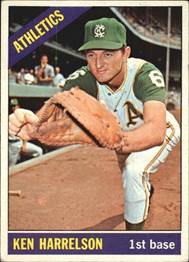
Harrelson moved up to the majors for good in 1965, but his flashy lifestyle and pool and golf hustling did not sit well with owner Charlie Finley. They argued publicly and privately, prompting Finley to trade him to Washington in 1966 mid-season, only to buy him back early in the 1967 season. In August that year, Finley suspended pitcher Lew Krause on what many believed were bogus charges. The players were appalled and Harrelson was quoted in the papers as saying Finley was a “menace to baseball.” Harrelson said he did not make the statement, but the outraged Finley put him on irrevocable waivers. Dumb move. This made Harrelson a free agent, not a common occurrence in those days.
Result: Finley got nothing. The Hawk and his batting glove got a big free agent contract from Boston. He helped the Red Sox win the 1967 AL pennant and then gave them a banner year in 1968, finishing third in the MVP voting. He retired in 1971 after nine years in the majors.
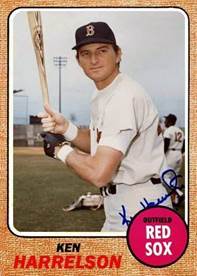
Carlos Beltran and the Royals/Mets/Astros: The Royals have one player in the Hall of Fame – George Brett. They have some bragging rights for a second player, assuming the voters do the right thing when Carlos Beltran becomes eligible in 2022. Carlos played six plus years for both the Royals and Mets during his 20-year career. Based on WAR stats, he is the 8th best center fielder in MLB history. That puts him behind only Mike Trout and six Hall of Famers (Mays, Cobb, Speaker, Mantle, Griffey and DiMaggio). He has a higher WAR than 13 other center fielders already in the Hall of Fame. He’s got my vote.
And remember that top 100 list that is being counted down by Joe Posnanski in The Athletic? While I was working on this post, Joe has gone from #100 to #92. Carlos Beltran is #98! In Joe’s essay, he emphasizes Beltran’s mix of power and speed. Four players have more than 400 homers, 500 doubles, 1,500 RBIs, 1,500 runs and 300 stolen bases. Willie Mays, Barry Bonds, Alex Rodriguez and Carlos Beltran. If you add one more stat – fewer than 50 times caught stealing – Beltran is the only one that fits. He is the most efficient base stealer among all players with 200 or more steals (86.4%). You can consider this as another unpaid ad of why you should subscribe to The Athletic (click here for “The Baseball 100” link).

In April of 2007, Rita and I had some good seats to watch the Mets in Shea Stadium. Her cool hat was noticed by a cameraman who put us on kiss-cam. In the photo below, the player partially hidden by Rita’s hat is the Mets #15, Carlos Beltran.
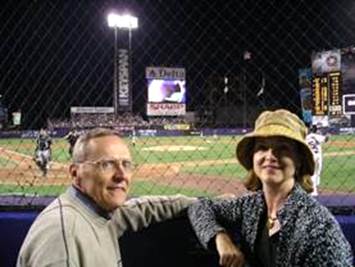
Carlos is now back with the Mets, this time as the manager for the upcoming 2020 season. His last year as a player was in 2017 with Houston. He was considered a valuable veteran presence in the Astros clubhouse as the team won the 2017 NL pennant and their first World Series.
Whoops. The 2017 Astros are under investigation for illegally stealing signs. One of the possible participants in the scheme was their savvy veteran Carlos Beltran. Suspensions may be coming down. Could be a tough way to start 2020.
At the Movies: Little Women opened yesterday. Two thumbs up from Rita and me. Prediction: Irish actress Saoirse Ronan will receive her fourth Oscar nomination. She’s only 25.
For your smaller screen at home, this is a reminder that two of our favorites out of Telluride are running on Netflix. The Two Popes and Marriage Story. The writing and acting of both will likely be honored when the Academy Award nominations are announced on January 13. The Oscars will be awarded February 9. In the meantime, here is an Oscar story from decades ago.
This past Sunday, two items connected for me. First, on CBS Sunday Morning, there was a feature on Irving Berlin, the Jewish immigrant who composed “White Christmas.” Second, Hot Stove reader Richard Martin tweeted a cool video – a dancing Fred Astaire hitting golf balls in the 1938 movie Carefree. The music in the video was part of the Irving Berlin score nominated for an Oscar. Fans of golf and Astaire will love this clip (click here – 1:45).
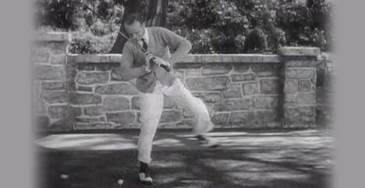
Berlin did not win an Oscar for his work in Carefree, but he won a few years later for best song: “White Christmas,” sung by Bing Crosby in the 1942 musical Holiday Inn. The awards ceremony was somewhat awkward. Berlin was the presenter for the Oscar and read his own name when he opened the envelope. It was the first time it had happened. It was also the last. The Academy established a protocol to assure it would never happen again.
Linda Ronstadt Update: Earlier this year, Lonnie’s Jukebox featured Linda Ronstadt in two posts (#92 and #94). She was also the subject of an excellent documentary this past summer and was one of the honorees at the recent Kennedy Center Honors. I’m talking about her again to give you a heads-up. That documentary (Linda Ronstadt: The Sound of My Voice) will air on CNN on New Year’s Day (8 p.m. CT). I encourage you to set your DVR. Click here for the trailer (2:28).
Lonnie’s Jukebox – Downtown/Escape: In January of 1965, Ken Harrelson and I continued our parallel lives, now at age 23. He was getting ready for spring training for what would turn out to be his first full season in the majors. I was in my first year in law school. Classes took up my morning, and then I went downtown to clerk at the Hovey patent law firm. I worked there all three years of law school, intending to use my engineering degrees to become a patent lawyer. I changed my mind on that, but will never forget the mentorship provided by Gordon Schmidt, Bob Hovey and Warren Williams. Great people.
This is my long way of introducing the number one song from January of 1965. Did you catch that the Hovey firm was downtown? So was Petula Clark who hit #1 with her first big hit. “Downtown” was the perfect record to match up for my trips from law school at UMKC to the Hovey offices downtown. Great song. Click here to listen.
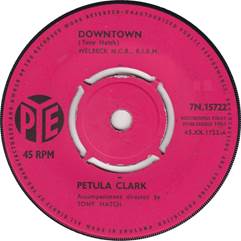
If you think that was a stretch, how about this one? On January 12, 1980, the number one song was “Escape (The Piña Colada Song).” Forty years later (i.e., next month), Rita and I are escaping to Cabo in Mexico for a week of warm weather. We will more likely be drinking Dos Equis than piña coladas. Click here to listen.

Coming Next Month: The first post of 2020 will be my annual message for Martin Luther King Jr. Day. It will tie together a variety of people: Charlie Finley, Campy Campaneris, Bull Connor, Paul Linblad, George Wallace, Bear Bryant, Willie Mays, Blue Moon Odom and risk-taker Albert Belcher. How so? Stay tuned.
Plaza Lights: For six weeks every winter, Rita and I have a special view from our condo. The Plaza Lights are on from Thanksgiving to early January. Below, from my trusty iPhone, sunrise on Christmas Eve morning.

Happy New Year!